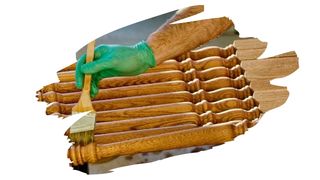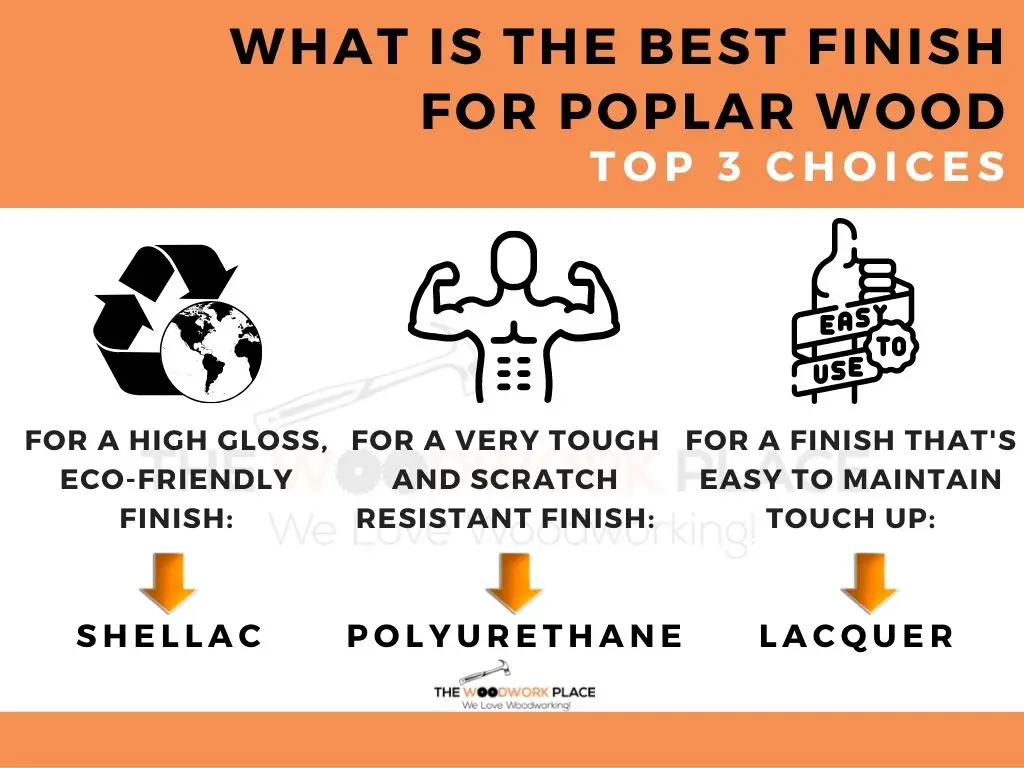Polyurethane is a pretty easy finish to use. It seals, waterproofs, and protects all-in-one. And, it can do all of that when applied to most any type of wood.
But, Poplar wood is a notoriously tricky lumber to seal. It doesn’t take stains well… and oil finishes can end up looking blotchy too.
This is because Poplar’s wood surface has areas that are spongier than other parts. So, if a finish needs to ‘soak’ into wood, (the way that stains and oils do), they won’t soak into Poplar wood evenly.
In fact, Poplar wood is what we call a ‘Paint Grade’ wood. In other words, this is a fancy way of saying that the only finish this timber can take well is a coat of paint.
But what about Polyurethane? A polyurethane finish works by wrapping wood in a water-tight (and incredibly tough) film.
Polyurethane finishes also soak into wood, (at least the first coat will). However, unlike stains and finishes, poly doesn’t need to penetrate wood to work its magic.
So, can you use a polyurethane finish on poplar wood?
You can use polyurethane on poplar wood. A wipe-on poly product will require 5-6 coats to evenly seal poplar wood (without leaving behind any blotchy spots).
But, while polyurethane doesn’t need to sink into wood, that doesn’t mean Poplar won’t try and soak up that poly just as much as any other finish.
Which begs the question… should you treat Poplar wood before application? Or will adding wood conditioner turn out to be a waste of time (and money)?
And is polyurethane really the best choice of finish for Poplar in the first place?…

This post may contain affiliate links to products that we receive a commission for (at no additional cost to you). Learn more here.
First Things First, How Do You Protect Poplar Wood?
If you just want to protect Poplar wood, (and you aren’t looking to add stain or color to it), then you can use Lacquer, Polyurethane or Shellac to seal it.
Lacquer lasts longer than Polyurethane, but poly undoubtedly gives wood a more resilient coat.
Also, poly will leave behind a clear satin finish that feels more like natural wood. While Lacquer and Shellac offer up a much more shinier glossy end product.
All three sealants, regardless, provide excellent waterproofing. Something that Poplar wood really needs, as Poplar is a moisture-magnet, making it very prone to swelling.
Related Post: What Is The Difference Between Lacquer and Polyurethane?
Fair Enough… So Which One Is The Best Finish For Poplar Wood?
It depends on what you want from your sealant:
- For a finish that is high gloss and eco-friendly: Use Shellac.
- For a finish that is the most scratch resistant: Use Polyurethane.
- For a finish that is easy to maintain and touch up: Use Lacquer
Related Post: What Can You Do When Your Polyurethane Finish Is Too Shiny?

Can I Put Polyurethane Directly Onto Bare Wood?
Yes, polyurethane can be wiped directly onto bare Poplar wood. You don’t need to treat the wood with anything.
The job of a wood conditioner is to fill in wood pores so as to slow down the ‘soaking-in’ speed of wood stain afterwards.
But in the case of clear polyurethane this isn’t a problem, since poly doesn’t need to penetrate wood in order to work effectively.
Related Post: Should I Apply Wood Conditioner Before Danish Oil? (Explained)
So, You Don’t Need Wood Conditioner For Poplar Wood, Right?
When it comes to applying poly, then no, you don’t need wood conditioner.
You can just wipe the polyurethane directly onto bare wood.
However, it is worth stating that you will need to apply a fair few coats to get a really even finish.
Related Post: Why Does Wood Feel Rough After Applying Polyurethane?
Generally, around 2-3 coats of polyurethane is enough on most other wood types. But, that won’t cut it with Poplar.
Instead, when applying polyurethane, Poplar will need 5 or 6 coats of the stuff.
Can You Use Water Based Polyurethane On Poplar? Yes you can. It’ll work just fine at sealing up Poplar surfaces. Just make sure you lightly sand, (with 220 grit sandpaper), between each poly coat.
Related Post: Here’s Why Sealing Poplar For Outdoor Use Doesn’t Really Work
So To Sum Up…
If you want a very scratch resistant finish, (and you don’t mind giving natural wood a bit of a satin sheen), then poly is a great choice for a Poplar wood sealant.


